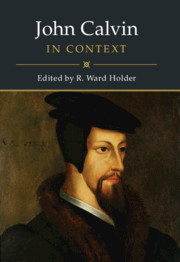Book contents
- John Calvin in Context
- John Calvin in Context
- Copyright page
- Dedication
- Contents
- Contributors
- Acknowledgments
- Abbreviations
- Introduction
- Part I France and Its Influence
- Part II Switzerland, Southern Germany, and Geneva
- Part III Empire and Society
- 15 The Politics of the Emperors
- 16 Judaism in Europe during the Late Middle Ages and Renaissance
- 17 Refugees
- 18 Calvin and Women
- Part IV The Religious Question
- Part V Calvin’s Influences
- Part VI Calvin’s Reception
- Conclusion
- Bibliography
- Index
- References
16 - Judaism in Europe during the Late Middle Ages and Renaissance
from Part III - Empire and Society
Published online by Cambridge University Press: 14 November 2019
- John Calvin in Context
- John Calvin in Context
- Copyright page
- Dedication
- Contents
- Contributors
- Acknowledgments
- Abbreviations
- Introduction
- Part I France and Its Influence
- Part II Switzerland, Southern Germany, and Geneva
- Part III Empire and Society
- 15 The Politics of the Emperors
- 16 Judaism in Europe during the Late Middle Ages and Renaissance
- 17 Refugees
- 18 Calvin and Women
- Part IV The Religious Question
- Part V Calvin’s Influences
- Part VI Calvin’s Reception
- Conclusion
- Bibliography
- Index
- References
Summary
In the Middle Ages and the sixteenth century, Jews and Jewish communities faced severe existential threats nearly everywhere in Western and Central Europe. The many types of persecution included banishment, forced conversion, confiscation of property, cancellation of debts, as well as assault and murder. Sometimes anti-Jewish violence erupted spontaneously, and sometimes it resulted from legally conducted prosecution of Jewish victims. During this long period, the number of territories that permitted Jewish residency contracted steadily until the second half of the sixteenth century, when more favorable conditions slowly began to develop in some areas of Europe. The wave of expulsions began with England in 1290, followed by France in 1394, and crested, but did not entirely dissipate, with the banishment of Sephardic Jews from Spain in 1492 and from Portugal in 1497. Significant Jewish communities in Sicily (1493) and the Kingdom of Naples (1511–1541) were also banished in the aftermath of the Spanish decree. The Sephardic expulsions as well as the preceding century of anti-Jewish agitation in Spain (beginning with widespread pogroms in 1391) resulted in tens of thousands of coercive baptisms and, subsequently, the development of a large Converso population. As many Conversos continued to practice Judaism surreptitiously, they became the targets of the Spanish and, later, Portuguese inquisitions (established in 1478 and 1536, respectively). Moreover, the Iberian expulsions dispersed the thriving Sephardic communities to the Ottoman Empire, parts of Italy, and, as of circa 1600, to the northern port cities of Amsterdam and Hamburg, as well as, beginning in the 1650s, to London. These port cities became important venues for the foundation of new, highly influential Jewish communities.
Keywords
- Type
- Chapter
- Information
- John Calvin in Context , pp. 139 - 146Publisher: Cambridge University PressPrint publication year: 2019

